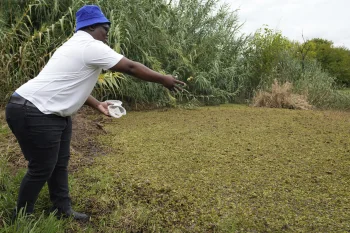In the battle against invasive species, scientists are increasingly turning to nature for solutions. A promising development has emerged from the wetlands of Louisiana, where researchers hope that a tiny warrior—the water hyacinth weevil—can help tackle the extensive problem of invasive water plants in South Africa. This article explores the facts and evidence behind this innovative biocontrol strategy.
The Invasive Challenge
Water hyacinth (Eichhornia crassipes) is a highly invasive aquatic plant that thrives in stagnant waters. Originating from the Amazon Basin, it has spread to water bodies worldwide, causing significant ecological and economic harm. In South Africa, water hyacinth has been a particular menace, severely clogging rivers, dams, and irrigation systems. This not only disrupts local ecosystems but also affects agriculture and water management, costing millions in mitigation efforts.
Enter the Weevil
Scientists have identified the water hyacinth weevil (Neochetina eichhorniae and Neochetina bruchi) as a potential biocontrol agent. Native to the American Southeast, these small beetles are known to feed exclusively on the water hyacinth plant. Their larvae burrow into the plant tissue, causing significant damage and reducing reproduction rates. A study published in the journal Biocontrol highlights their effectiveness in other regions, where they have successfully brought down water hyacinth populations.
Evidence of Effectiveness
Recent research comparing water hyacinth populations with and without weevil infestation has revealed striking outcomes. In areas where weevils were introduced, researchers observed up to 90% reductions in biomass over a two-year period. Notably, the weevils are capable of reproducing rapidly, leading to self-sustaining populations that maintain pressure on the invasive plants.
Moreover, scientists have been monitoring the ecological impact of these weevils in Louisiana. By studying their effects on local environments, researchers can ensure that introducing them to South Africa poses minimal risk of unintended consequences. Thus far, results indicate that the weevils do not harm native plant species, making them a safe option for biocontrol.
The Implementation Process
The process of introducing a biological control agent involves rigorous evaluation to prevent ecological disturbances. In South Africa, scientists from the Agricultural Research Council (ARC) are leading extensive research on the weevil’s potential introduction. They are collaborating with local stakeholders, including farmers and conservationists, to design a comprehensive management plan.
Prior to the actual release, a series of trials will be conducted to assess the weevils’ adaptability to South African conditions. Controlled environments will replicate local aquatic habitats to ensure that the weevils can survive and thrive before being unleashed into the wild.
A Sustainable Future?
The introduction of the water hyacinth weevil could pave the way for sustainable management of invasive aquatic plants in South Africa. This biocontrol method not only offers a cost-effective alternative to chemical herbicides—often criticized for their harmful environmental impacts—but also promotes biodiversity by reducing competition for native species.
However, as with any biocontrol strategy, careful monitoring will be essential. Researchers will track the weevils’ impact on the aquatic ecosystem, ensuring that they remain effective without causing unforeseen ecological shifts.
Conclusion
The potential of Louisiana’s hungry weevils offers a glimmer of hope in the fight against the invasive water hyacinth that plagues South Africa’s waterways. With ongoing research and careful planning, this innovative biocontrol strategy could herald a new era of ecological balance and sustainability. As scientists continue their efforts, the world watches closely, hopeful that nature may provide the solutions desperately needed to restore South Africa’s aquatic ecosystems.
Email Us on editorial@nnafrica.com













